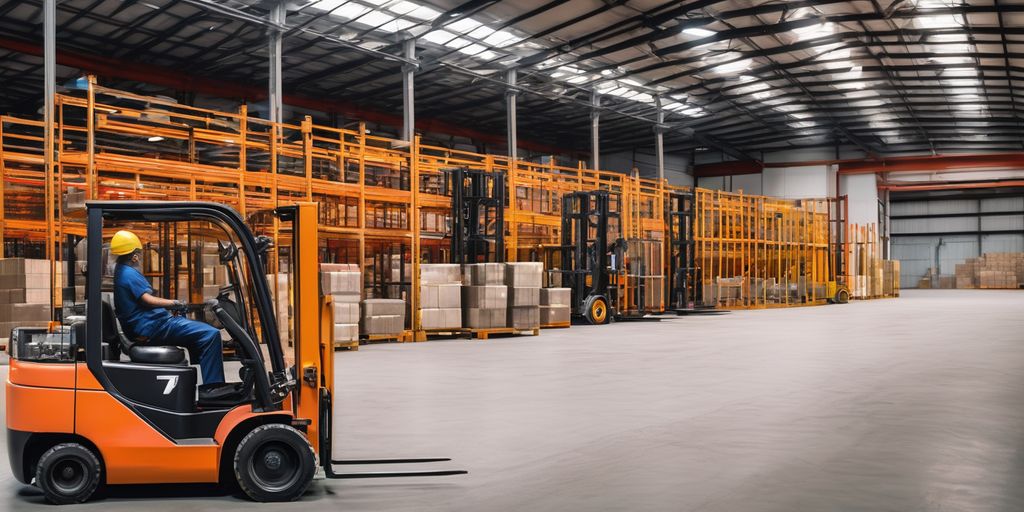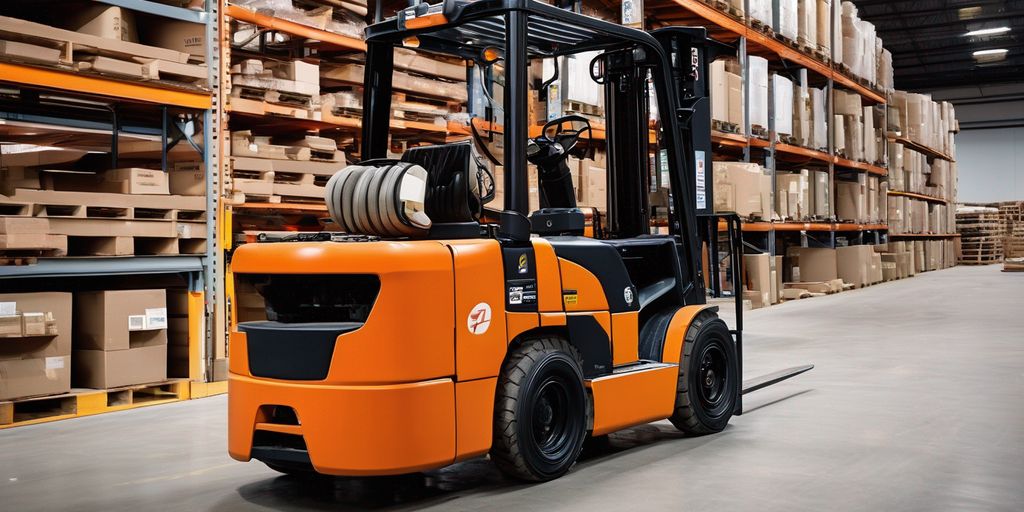Elegir el montacargas adecuado: consideraciones clave para las necesidades de su negocio — overview
Elegir el montacargas adecuado para su negocio es una decisión crítica que puede afectar significativamente su eficiencia operativa y productividad. Con varios tipos de montacargas disponibles, cada uno diseñado para tareas y entornos específicos, es esencial evaluar minuciosamente las necesidades de su negocio y las características de cada tipo de montacargas. Esta guía lo ayudará a navegar por las consideraciones clave para asegurarse de seleccionar el montacargas óptimo para su negocio.
Conclusiones clave
- Comprenda los diferentes tipos de montacargas y sus aplicaciones específicas para satisfacer sus necesidades operativas.
- Evalúe la capacidad de carga y los requisitos de altura de elevación para garantizar que el montacargas pueda manejar sus cargas típicas de manera segura y eficiente.
- Considere las opciones de combustible y la eficiencia de los montacargas para encontrar la solución más rentable y respetuosa con el medio ambiente.
- Evalúe su entorno de trabajo y su terreno para elegir un montacargas que pueda operar de manera efectiva en sus condiciones específicas.
- Priorice las características de seguridad y el diseño ergonómico para mejorar la comodidad del operador y reducir el riesgo de accidentes.
Comprender los diferentes tipos de montacargas
A la hora de elegir la carretilla elevadora adecuada, conviene familiarizarse con las opciones disponibles. Conocer los distintos tipos es fundamental a la hora de elegir la carretilla elevadora que mejor se adapte a sus necesidades. Los distintos tipos de carretillas elevadoras incluyen:
Evaluación de la capacidad de carga y la altura de elevación

Al seleccionar un montacargas, evaluar la capacidad de elevación es crucial, ya que afecta directamente tanto a la seguridad como a la eficiencia operativa. La capacidad de un montacargas para levantar y transportar cargas debe coincidir con las necesidades habituales de su negocio. Es importante considerar no sólo el peso máximo sino también la altura a la que se puede elevar la carga.
Asegúrese de que el montacargas que elija pueda soportar el peso máximo que sus operaciones comerciales requieren de forma regular.
Considerando las opciones de combustible y la eficiencia
Elegir la opción de combustible adecuada para su carretilla elevadora es esencial para maximizar la eficiencia y satisfacer las necesidades de su negocio. Cada tipo de combustible tiene su propio conjunto de ventajas y limitaciones , por lo que es fundamental evaluarlos en función de sus requisitos operativos específicos.
Montacargas eléctricos
Las carretillas elevadoras eléctricas funcionan con baterías de plomo-ácido grandes y pesadas, que suelen proporcionar suficiente energía para un turno estándar de ocho horas o unas cinco o seis horas de uso continuo. Las dos mayores ventajas de este sistema son que produce cero emisiones y es muy económico en términos de combustible . Esto hace que las carretillas elevadoras eléctricas sean una excelente opción para operaciones en interiores donde la calidad del aire es una preocupación.
Carretillas elevadoras de combustión interna
Las carretillas elevadoras de combustión interna (IC) funcionan con diésel, propano (GLP) o gas natural comprimido (GNC). Estos montacargas son generalmente más potentes y pueden manejar cargas más pesadas en comparación con sus homólogos eléctricos. Sin embargo, producen emisiones, lo que los hace menos adecuados para uso en interiores. Las carretillas elevadoras IC son ideales para operaciones en exteriores y entornos donde se requiere alta potencia y resistencia.
Montacargas de Combustible Alternativo
Las opciones de combustibles alternativos, como las pilas de combustible de hidrógeno, están surgiendo como opciones viables para las operaciones con montacargas. Estas opciones ofrecen los beneficios de un repostaje rápido y emisiones reducidas. Si bien todavía son relativamente nuevos, están ganando terreno en industrias centradas en la sostenibilidad y la eficiencia.
Seleccionar el tipo de energía adecuado es una decisión crucial que puede afectar significativamente su eficiencia operativa y el cumplimiento de las regulaciones de emisiones.
Evaluación del Entorno Laboral y Terreno
Al elegir una carretilla elevadora, es fundamental evaluar el entorno principal donde se utilizará. Los ambientes interiores y exteriores presentan diferentes desafíos y requisitos para las carretillas elevadoras. El tipo de terreno en el que operará su montacargas está estrechamente relacionado con si lo usará en interiores o exteriores. El terreno interior normalmente será una superficie lisa de cemento que se encuentra en la mayoría de los almacenes y muelles de carga, y esta superficie es ideal para las ruedas pequeñas y sólidas de un montacargas eléctrico.
El terreno exterior, que puede ser asfalto, grava o incluso terreno crudo, suele ser mucho menos uniforme que las superficies interiores. Esto influirá en el tipo de rueda y el suministro de energía que necesita su carretilla elevadora.
Uso en interiores vs. exteriores
Los ambientes interiores suelen tener superficies lisas de cemento, lo que los hace ideales para carretillas elevadoras eléctricas con ruedas pequeñas y sólidas. Por otro lado, los ambientes exteriores pueden variar significativamente, desde asfalto hasta grava o suelos irregulares. Esta variabilidad requiere carretillas elevadoras con características más resistentes y una selección adecuada de neumáticos para garantizar el rendimiento, la seguridad y la eficiencia.
Navegando Pasillos Estrechos
En muchos almacenes, el espacio es un bien escaso y los montacargas deben poder circular por pasillos estrechos de manera eficiente. Las carretillas retráctiles y otros montacargas especializados están diseñados para operar en estos espacios confinados, ofreciendo mayor maniobrabilidad y precisión.
Manejo de Terreno Accidentado
Para las operaciones que requieren que las carretillas elevadoras se desplacen en terrenos difíciles, como sitios de construcción o áreas de almacenamiento al aire libre, es esencial elegir modelos diseñados para estas condiciones. La maniobrabilidad es clave cuando se transita por terrenos difíciles, por lo que se deben buscar carretillas elevadoras con dirección sensible y manejo ágil. Además, los neumáticos sólidos o neumáticos son los más adecuados para estos entornos para garantizar la estabilidad y la durabilidad.
Priorizar las características de seguridad y la ergonomía
Al seleccionar una carretilla elevadora, la seguridad debe ser la máxima prioridad. Las características clave a considerar incluyen la estabilidad, la visibilidad desde la cabina y la presencia de recintos de seguridad. Los sistemas de frenado eficaces, los sistemas de advertencia y el control de velocidad son esenciales para prevenir accidentes. Además, los sistemas de retención del operador y de parada de emergencia brindan medidas de seguridad críticas en caso de una emergencia.
Diseño ergonomico
Es importante contar con asientos ajustables y de alta calidad, ya que los operadores de carretillas elevadoras pasan muchas horas sentados en sus máquinas. El diseño y la ubicación de los controles también son importantes. Invertir en ergonomía de calidad reducirá la probabilidad de sufrir lesiones, como dolor de espalda o síndrome del túnel carpiano, que pueden ser causadas por tareas repetitivas realizadas en asientos y condiciones de alcance incómodos.
Capacitación y certificación de operadores
Garantizar que los operadores estén capacitados y certificados adecuadamente es crucial para mantener un entorno de trabajo seguro. Las sesiones periódicas de capacitación y las renovaciones de certificaciones ayudan a mantener a los operadores actualizados con los últimos protocolos de seguridad y técnicas operativas.
Dar prioridad a la seguridad y la ergonomía del operador de montacargas no solo mejora la productividad sino que también reduce el riesgo de lesiones en el lugar de trabajo.
Analizando el Costo Total de Propiedad
Comprender el [total cost of ownership](https://www.aaaforklifts.com/blogs/news/10-key-considerations-when-buying-a-forklift-for-your-business-1) es fundamental a la hora de considerar un montacargas para su negocio. Esto incluye no solo el precio de compra, sino también los costos a largo plazo, como el mantenimiento, el combustible y el posible tiempo de inactividad. A continuación, se indican algunos factores clave a tener en cuenta:
Es importante calcular estos gastos durante la vida útil del montacargas para tener una idea real de cuál será el costo total de propiedad. Utilizar el coste total de propiedad como principio rector puede ayudar a evitar tensiones financieras imprevistas.
Explorando Avances Tecnológicos
Los sistemas telemáticos están revolucionando la forma en que las empresas gestionan sus flotas de carretillas elevadoras. Al proporcionar datos en tiempo real sobre el uso de montacargas, las necesidades de mantenimiento y el desempeño del operador, estos sistemas ayudan a optimizar las operaciones y reducir el tiempo de inactividad. Los beneficios clave incluyen:
- Seguimiento mejorado de la ubicación y el uso del montacargas
- Alertas de mantenimiento predictivo
- Monitoreo mejorado del desempeño del operador
La automatización y la robótica están a la vanguardia de la tecnología de montacargas. Los vehículos guiados automatizados (AGV) y los robots móviles autónomos (AMR) se utilizan cada vez más para optimizar las operaciones de almacén. Estas tecnologías ofrecen:
- Mayor eficiencia y productividad
- Costos laborales reducidos
- Mayor seguridad al minimizar el error humano
Adoptar la automatización puede preparar sus operaciones para el futuro y mantenerlo competitivo en un mercado en rápida evolución.
Los sistemas de seguridad avanzados son cruciales para las operaciones modernas de montacargas. Funciones como la prevención de colisiones, el monitoreo en tiempo real y los sistemas de asistencia al operador mejoran significativamente la seguridad en el lugar de trabajo. Considere los siguientes avances:
- Sistemas de detección y prevención de colisiones.
- Módulos de asistencia y formación al operador.
- Monitoreo y alertas en tiempo real para condiciones peligrosas.
Conclusión
En conclusión, seleccionar el montacargas adecuado para su negocio es un proceso multifacético que requiere una cuidadosa consideración de varios factores. Desde evaluar sus necesidades operativas específicas y comprender los tipos de cargas que maneja, hasta evaluar el entorno de trabajo y garantizar el cumplimiento de las normas de seguridad, cada aspecto desempeña un papel crucial a la hora de tomar una decisión informada. Al analizar minuciosamente estos elementos, podrá elegir un montacargas que no solo mejore la productividad y la eficiencia, sino que también contribuya a la seguridad y rentabilidad general de sus operaciones. Armado con los conocimientos proporcionados en esta guía, ahora está mejor equipado para navegar las complejidades de la selección de montacargas y tomar la decisión que mejor se alinee con sus necesidades comerciales.
Preguntas frecuentes
¿Cuáles son los diferentes tipos de montacargas?
Los principales tipos de carretillas elevadoras incluyen carretillas elevadoras contrapesadas, carretillas retráctiles y transpaletas. Cada tipo atiende diferentes necesidades operativas y entornos.
¿Cómo determino la capacidad de carga necesaria para mi montacargas?
La capacidad de carga está determinada por la carga más pesada que necesita levantar. Es importante considerar el peso máximo y asegurarse de que el montacargas pueda manejarlo con seguridad.
¿Cuáles son los beneficios de las carretillas elevadoras eléctricas?
Los montacargas eléctricos son conocidos por su eficiencia, menores costos operativos y cero emisiones, lo que los hace ideales para uso en interiores y operaciones respetuosas con el medio ambiente.
¿Es necesaria la capacitación y certificación del operador?
Sí, la capacitación y certificación de los operadores son cruciales para la seguridad y el cumplimiento de las regulaciones. Una formación adecuada ayuda a prevenir accidentes y garantiza un funcionamiento eficiente.
¿Qué factores debo considerar para el uso de montacargas en interiores o exteriores?
Para uso en interiores, las carretillas elevadoras eléctricas suelen ser las preferidas debido a sus cero emisiones y su funcionamiento silencioso. Para uso en exteriores, considere montacargas que puedan manejar terrenos accidentados y condiciones climáticas variables.
¿Cómo afecta el coste total de propiedad a mi elección de montacargas?
El costo total de propiedad incluye el precio de compra inicial, los costos de mantenimiento y reparación y el valor potencial de reventa. La evaluación de estos factores ayuda a tomar una decisión rentable.




Deja un comentario
Este sitio está protegido por hCaptcha y se aplican la Política de privacidad de hCaptcha y los Términos del servicio.